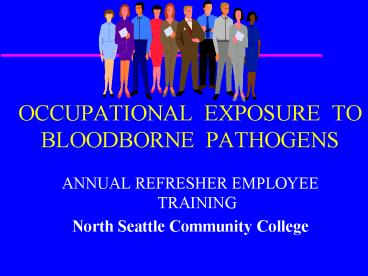OCCUPATIONAL EXPOSURE TO BLOODBORNE PATHOGENS - PowerPoint PPT Presentation
1 / 16
Title:
OCCUPATIONAL EXPOSURE TO BLOODBORNE PATHOGENS
Description:
Infectious germs (bacteria and viruses) that are present in human blood/body ... Using dustpan and brush to pick up broken glass in biohazard spill situation ... – PowerPoint PPT presentation
Number of Views:90
Avg rating:3.0/5.0
Title: OCCUPATIONAL EXPOSURE TO BLOODBORNE PATHOGENS
1
OCCUPATIONAL EXPOSURE TO BLOODBORNE PATHOGENS
- ANNUAL REFRESHER EMPLOYEE TRAINING
- North Seattle Community College
2
BLOODBORNE PATHOGENS
- Infectious germs (bacteria and viruses) that are
present in human blood/body fluids and can cause
disease in humans. These pathogens include, but
are not limited to, Hepatitis B (HBV), Hepatitis
C (HCV), and human immunodeficiency virus (HIV).
2
3
PURPOSE OF THIS TRAINING
- Protection against bloodborne pathogens
- NSCC Exposure Control Plan
- FEDERAL Occupational Exposure to Bloodborne
Pathogens Standard, Part 1910.1030, Title 29
Code of Federal Regulations (effective date
3/6/92) - WASHINGTON STATE Bloodborne Pathogens
Standard, WAC 296-62-08001 (effective date
5/26/92)
3
4
INFECTIOUS MATERIALS
- Blood
- All body fluids (such as diarrhea and vomit)
since all can be potentially contaminated with
blood or infectious germs - Viruses and bacteria that spread communicable
diseases through contact with bodily fluids. - any body fluid visibly contaminated with blood
4
5
Universal Precautions
- Wash hands
- Wear gloves
- Wear impervious gown or apron
- Wear appropriate PPE - including eye and mask
protection - mouth pieces for resuscitation while
administering First-Aid - Handle sharp objects carefully
6
Engineering Controls
- Labeled sharp containers
- Biohazard bags and containers
- Specific collection site for disposal of
contaminated waste and PPE - campus Shipping and
Receiving - Using dustpan and brush to pick up broken glass
in biohazard spill situation - Hand washing facilities, eyewashes and/or showers
shall be provided as close as possible to work
area
7
Work Practice Controls
- Minimize splashing, spraying and generation of
droplets of blood or OPIM - Wash hands as soon as possible after exposure
incident - Do not recap or break contaminated sharps
- Do not keep food or beverages or eat or drink in
contaminated work areas
8
Personal Protective Equipment
- Eye protection
- Gloves
- Protective clothing
- Removal and cleaning of PPE
- Availability and Accessibility
9
EXPOSURE INCIDENT PROCEDURES
- Cleanse exposed area THOROUGHLY
- -if open wound, milk entry wound
- Eyes flush w/large amounts of running water
for a minimum of 15 minutes - Mouth rinse out thoroughly
Nose blow nose wipe inside nostrils - - see App G
- Seek Professional Medical Care immediately
- Report incident to your supervisor.
- Complete necessary NSCC forms
- Exposure Incident Report App I
30
10
WHEN TO WEAR GLOVES
- If handling contaminated disposable items
- If direct hand contact with body fluids is
anticipated (e.g., when providing first aid) - If cleaning up body fluid spills.
- When disinfecting surfaces or articles.
25
11
HANDWASHING
- before drinking, eating, or smoking
- before handling clean utensils, equipment or food
- before and after going to the bathroom
- after contact with any body fluid
- after removing disposable gloves or other
protective equipment
24
12
DISINFECT PROPERLY
- Wear disposable latex gloves and appropriate PPE
- Use a proper disinfectant
- -One part bleach to nine parts water is recipe
for disinfectant. - -New solution must be made daily to be
effective. - Let disinfectant sit at least 1-2 minutes -up to
ten minutes. - Use paper towels to clean up spills and place in
lined waste container. If they contain blood,
place in red biohazard bag. - Dispose of gloves and wash hands thoroughly.
- Use paper towels to turn off faucet
26
13
Disposal of gloves and contaminated articles
- Dispose of gloves and all contaminated articles
containing blood or body fluids (band-aids,
dressings) in red plastic bags and identify as a
biohazard. - Wash your hands thoroughly after
removing gloves!
27
14
Information and Training
- Employee will receive training at commencement of
employment - Yearly refresher training
- Whenever scope of duties are changed to effect
employee occupational exposure to BBP - Yearly program review
15
Hepatitis B Vaccination Program
- Offered to all covered employees at no cost
- Made available within 10 days of initial
assignment and is not mandatory - Employees may decline vaccination and accept at a
later date - waiver form (App E) - All employees exposed to blood or OPIM on the job
will be offered vaccination and post exposure
evaluation and treatment
16
In Summary Avoid BBP Exposures!
- Practice Universal Precautions
- Monitor Personal Hygiene
- Practice Good Housekeeping
- Dispose of Wastes Properly
ANY QUESTIONS??
31































